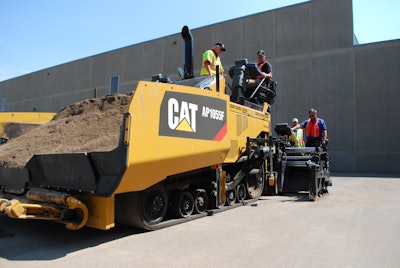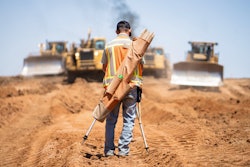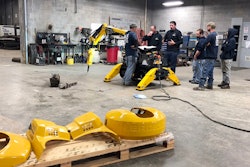
By Todd Mansell, Caterpillar Paving Products
Gone are the days when an employee stayed with a company for life. Statistics show that construction workers have among the highest employee turnover rates in any industry at approximately 25% per year.
How can a paving contractor ensure crews continue to be ready to meet the jobsite challenges – and help turn a profit, too?
The answer is training. Contractors must invest in training and educate their workforce. They also must establish mechanisms to ensure knowledge and experience are transferred to new employees. Meeting these goals is crucial to staying competitive in today’s marketplace.
The first steps to implementation
First, look at what you have, and decide where you want to be. This should include your corporate objectives and consideration of the construction industry’s direction as a whole.
You might ask, “Where do we want to be five years from now?” An effective training program starts with a structured plan to meet specified goals by a certain date. Decide what specific areas of training you want to focus on and design a curriculum.
Second, a financial investment is required. Training, whether done in-house or by outside consultants, requires money for salaries of trainers and trainees, course materials, and paid time for employees to undergo training.
Finally, consider some lost production costs on projects where field training is being done. Costs associated with lost production can be minimal if training is integrated into the project through careful coordination of field operations.
Generally, a mix of classroom and field training will meet your needs. Web-based training for construction workers has improved, though the quality of online training remains limited.
Using your training curriculum as a guide, determine what results will be tracked to ensure that training effectiveness can be measured. An example might be tracking improvement of the average percent compaction on asphalt-paving jobs from month-to-month and year-to-year. The more specific the measurement items are, the better understanding you will have of the effectiveness of training and how to improve it.
Several methods have been proposed to assess training effectiveness, such as written tests for the classroom training and field demonstration audits that evaluate individual operators on a rating scale on specific tasks. The rating must be as objective as possible so that all workers are rated on the same basis.
The most effective training comes from workers asking questions and having the freedom to try new approaches. Encourage your workforce to ask questions. Provide answers or direct them toward a solution by encouraging them to test their idea. A thinking worker is an innovative and efficient worker.
Recognize accomplishments. Evaluate your crews on the basics. Consider having your crews evaluate themselves and ask them in what areas they would like additional training.
Support what you say through investment in training and equipment. The over-arching themes of any training program should be to ask questions and learn by doing. When people are given a “safe” environment where they can try their ideas, the results will stick with them forever.
How to structure the program
Here are five ways to structure a successful training program.
1. Maintain a record of Best Practices
Although some practices are industry standard, others will be specific to your operation depending on the type of equipment you use and other factors. A record of Best Practices enables employees to focus on what works and provides employers with a guide for measuring improvement.
Use Best Practices as a training tool for integrating new employees into your operation. The Best Practice for each task should be maintained as a live document that can be updated as new methods are learned. It is essential that a mechanism be in place to ensure the entire crew is aware of any changes.
2. Let employees establish Best Practices for doing a particular task
People come from many different company backgrounds and bring a wide variety of work experience with them. One of the best ways to share the experience of all employees is to have them collectively establish the Best Practice for a particular task.
This is perhaps the most challenging aspect of training construction crews. Realize that across-the-board consensus will not always be possible because many workers are reluctant to change. To react this way is human nature, since a change often implies that you’ve been doing it “wrong” up to this point.
In most situations where people resist change, they have not been given objective or quantitative feedback to make a fact-based decision on their technique. The only support they have in this situation is their intuition.
For example, in compacting hot-mix asphalt (HMA), a roller operator may have been trained that pinching a longitudinal joint from the cold side is the most effective way to make a durable, long-lasting joint. In fact, this is generally not the most effective method of HMA compaction. However, the operator was never given measured feedback (percent compaction numbers) as to the actual results of their method.
It is important in training to make decisions based on measurable information. This is how the owner will evaluate your job. “Because I said so” or “That’s the way it is” are not credible statements. Ask yourself how you would react if someone answered your questions with those phrases.
3. Use technology to provide immediate, quantitative feedback
For example, if you are training to minimize thermal segregation in the asphalt mat behind the paver, consider providing each crew member with an infrared temperature gun for immediate feedback so they can try new methods to improve their process.
Immediate feedback will give workers the opportunity to witness the results, make decisions, and update their Best Practice. Effective use of technology minimizes training costs and increases accountability by having employees “own” their training.
4. Foster a “safe” learning environment
Be sure to create an environment where people are not penalized for suggesting changes. Allow workers the freedom to suggest and try new ideas. Encourage them to ask questions and seek answers. It is human nature that people are more likely to believe what they see than what they hear.
Of course, ensure that employees are aware of the consequences of trying new things without the permission of a job supervisor. New methods are often best tested during a slow time.
5. Recognize mistakes as learning opportunities
We are human and make mistakes. Recognize mistakes and take advantage of them as learning opportunities. Often, the only way we know what does work is by knowing what does not work! Include this learning in your Best Practices.
Managing a successful training program is as much an exercise in managing people as it is in providing technical training. Understanding what motivates people is essential in developing a training program. Combine your company objectives with individual employees’ needs and develop a specific training curriculum.
Provide technical training, but also the tools and freedom to execute what is learned. Encourage process improvements that are based on facts. Keep records of Best Practices and continuously update the practices as new learning supports change. Maintain structure and send consistent messages to workers from all levels of management.
A well-planned and properly focused training program will result in quality products and innovative solutions that will improve your bottom line and benefit the construction industry as a whole.



















